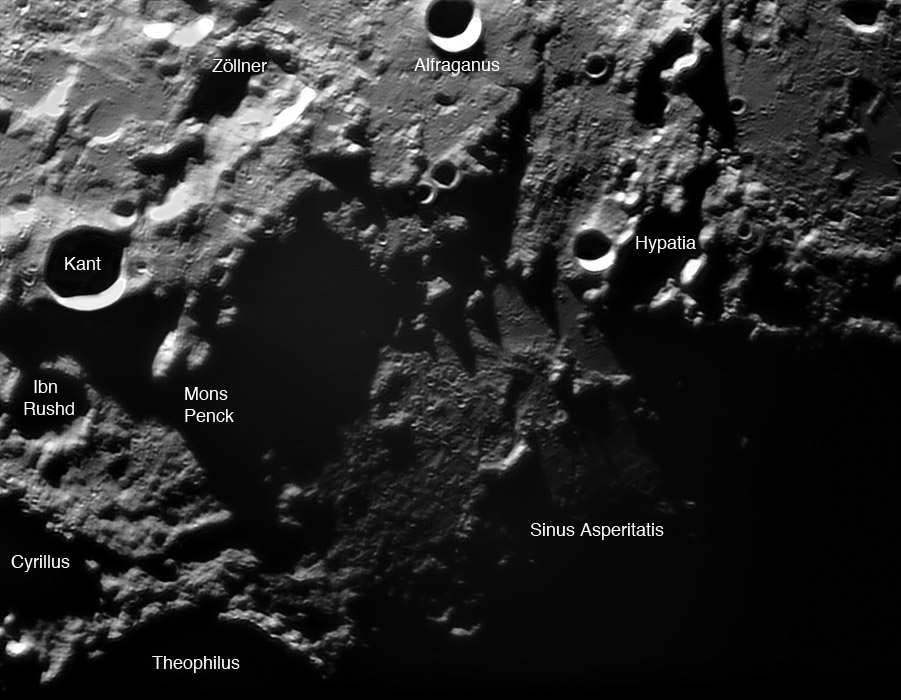
image by Павел Пресняков (Pavel Presnyakov), Kiev Ukraine
In detective stories criminals always return to the scene of the crime, and lunar imagers also return to their favorite haunts. Pavel’s sunrise image of the area west of Theophilus was the March 27 LPOD, and his sunset view (above) was yesterday’s mystery image. The low illumination of both of the images magnifies the small scale roughness of the surfaces and bring a different perspective to familiar areas. In the sunset view, the rims of Theophilus and Cyrillus look like they are made of nodules of modeling clay, roughly piled in circles. And the plateau east of Alfraganus looks like its covered by a pasty veneer of mud. In fact, the veneer is probably ejecta from the Nectaris Basin and from the younger crater Theophilus. The depressed area that cuts into the upper right of the image is an 111 km wide ancient ruin cataloged as number 43072A in The System of Lunar Craters, Quadrant IV.
Twenty-three LPODites sent emails correctly identifying this area and a number included their own images of the region. It was fascinating to see the effects of sunrise on viewers of LPOD - the first emails came from Europe, and then later from the eastern US, and finally from the Pacific coast and Japan. Many were from otherwise silent visitors to the site, including old friends and new acquaintances. A number of people seemed to think it was fun to be a sleuth and solve the mystery. The first piece of evidence reported was that the craters were round so the image was from near the center of the disk. The elevation difference from the top to the bottom suggested a scarp, and the clue of mare material (which had to be at the shadowy bottom right) implied that the area was on the west side of a mare area: Humorum or Nectaris seemed most likely. And then it was pretty easy to narrow it down to the Kant plateau to Hypatia region. This was fun. If LPOD gets some more intriguing images we will have a Mystery Moon contest each month. And I hope the winners enjoy their free subscriptions! Thanks, Pavel, for a great image!
Here is the list of people who correctly identified the image: Adolfo Jose Acevedo Vogl, André Gabriël, Bruno Daversin, Chasiotis Elias, David Storey, François Emond, Gary Seronik, George Kelley, Giuseppe Monachino, Helmbrecht Haberl, Henrik Bondo, Hylke Eg, Jeff Goswick, KC Paul, Kostas Kalimaftsis, Mick Hyde, Paolo R. Lazzarotti, Phil Morgan, Philip J Stooke, Sandi Bozic, Wilfried Tost.
Technical Details:
30.11.2007, 00:24 UT. TAL-250K + EVS-135, b/w 1280×1024 15fps + barlow 3x, 250 frames from 2000 in Registax4.
Related Links:
Rükl sheet 46
Pavel’s website
COMMENTS?
Register, and click on the Discussion tab at the top of the page.



